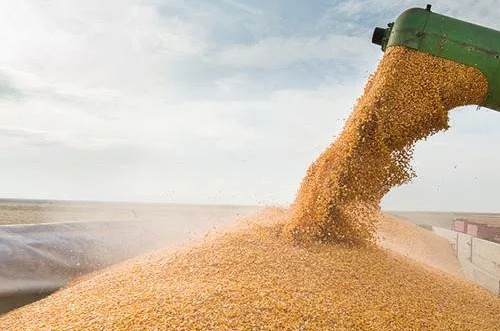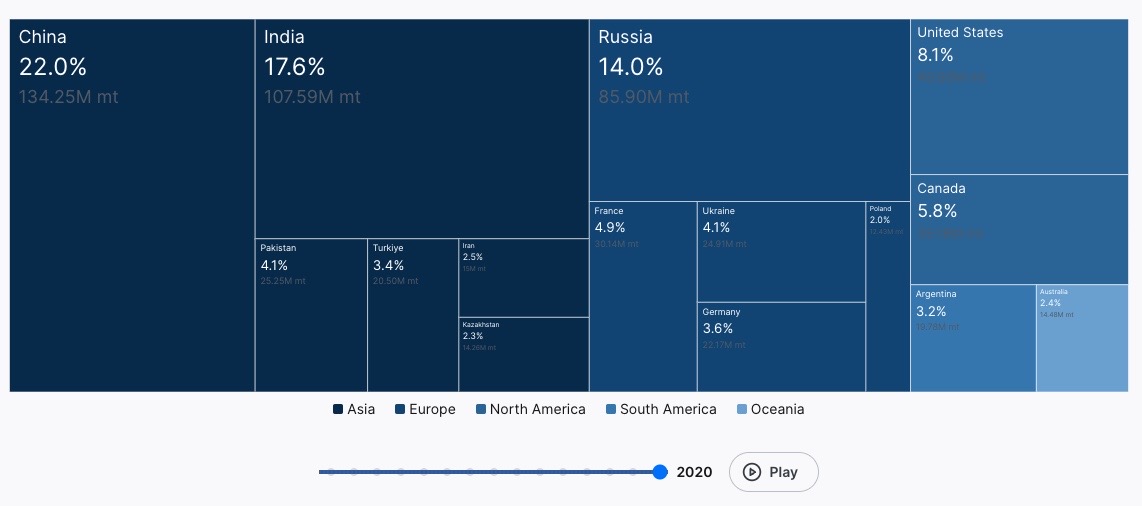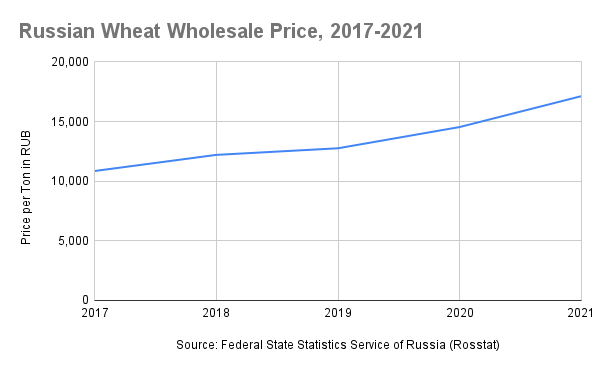Recent Wheat Market Trends in Russia and Their Implications to the Global Wheat Market

Russian Wheat Market Overview
Russia is one of the largest wheat markets in the world in terms of both production and exports which have a great impact on the global market . According to estimates of the Federal State Statistics Service of Russia (Rosstat), the wheat harvest reached 104.43 million tons in 2022, a 37% YoY increase compared with 76.1 million tons in 2021. According to various estimates, Russia's total wheat consumption has remained relatively consistent over the past 10 years, ranging from approximately 35.0 to 42.5 million metric tons per marketing year. The Ministry of Agriculture of the Russian Federation reports show that Russia exported around 40-45 million tons of wheat in 2021, around a 30% YoY increase compared with 34 million tons of wheat in the previous year. Recent trends in the Russian wheat market have been characterized by both challenges and opportunities. The war in Ukraine had significant implications for Russia's wheat market, its production and exports, disruptions to supply chains, and changes in global supply and demand dynamics.
Russian Wheat Production Surging to New Record
Russia's wheat production trends have been positive in recent years, with increased production levels, favorable weather conditions, technological improvements, and government support all contributing to higher yields. As can be seen in Figure 1 below, Russia's wheat production has been somewhat volatile over the past years, with visible fluctuations from year to year. However, the overall trend has been an increased production of wheat, reaching 85.9M mt in 2020 according to Tridge’s data. Very recent data announced by the Federal State Statistics Service of Russia (Rosstat) shows that the wheat harvest reached 104.43 million tons in 2022, a 37% YoY increase compared with 76.1 million tons in 2021.
Figure 1: Wheat Production Trends in Russia

Source: Tridge
Russia’s Share in Global Wheat Production
Russia is one of the world's leading wheat producers, and its share in global wheat production has been increasing in recent years. According to Tridge, Russia's share of global wheat production reached 14% in 2020, surpassing traditional producers of wheat such as the United States and Canada. Russia's growing share of global wheat production is driven by several factors, including favorable weather conditions for wheat cultivation, increased finance in agricultural technology and grain infrastructure, and government support for grain farmers. Additionally, the devaluation of RUB in recent years has made Russian grain products more competitive in the global market, leading to increased demand from importers.
Figure 2: Wheat Production by Countries

Source: Tridge
Steady Rise in Russia’s Wheat Consumption Domestically over the Past 5 Years
Wheat production in Russia over the past few years has reached high levels, ranging from 85 to 104.43 million tons for the period 2017-2022. Wheat exports from Russia have also grown significantly in recent years, and Russia has become one of the largest wheat exporters in the world. In 2021, Russia exported 41.3 million tons of wheat, which is a new record and expected to reach 43 million tons in 2022-23 years. Domestic consumption of wheat in Russia is also growing, but not as fast as exports. In 2021, it amounted to about 41.5 million tons. This is due to increased consumption of bread, bakery, meat and dairy products, as well as the development of the food industry and the production of animal feed. The production and export of wheat from Russia has increased significantly over the past few years, and Russia continues to be one of the largest producers and exporters of wheat in the world. At the same time, domestic consumption of wheat is also growing, although not as fast as production and exports.
Volatile Export Trends with Russian Wheat
Russia is also a major exporter of wheat, and in recent years, it has become a key player in the global wheat market. In the next figure below, it can be seen Russia's wheat export trends over the last 5 years (2017-2021 years). Government data shows that Russia's wheat exports have been somewhat volatile over the last 5 years, with significant fluctuations from year to year. However, the overall trend has been one of increased exports. According to the U.S. Department of Agriculture (USDA) World Agricultural Supply and Demand Estimates, Russian exports are expected to reach 43M mt in 2022-23 marketing year, 17% above the five-year average.

Upward and Downward Trends with Russian Wheat Price
Recently, Russia’s invasion of Ukraine also affected the overall wheat price not only in Russia but also in the global wheat market. Price chart for 2017-2021 years shows a stable increase of wholesale price of Russian wheat. In February 2022, the average wheat prices in Russia, according to Rosstat, amounted to 15,501 RUB/t.

Recent Tridge Weekly Price update (March 28, 2023) of Russian wheat (12.5% protein content) shows that export prices fell again to $272 after the Black Sea Grain Initiative extended for 60 days allowing the safe Black Sea export of Ukrainian grain, which supported the downward trend in world markets, alongside increased export volumes.
Russian Wheat Faced both Challenges and Opportunities
Recent trends in the Russian wheat market have been characterized by both challenges and opportunities . There has been a significant increase in the production of wheat in Russia over the past 10 years, making it one of the largest wheat producers in the world. This has led to a surge in exports, particularly to countries in the Middle East and North Africa, as well as Asia. Russian wheat is also becoming increasingly competitive in the global market due to its relatively low prices.
On the other hand, the COVID-19 pandemic has disrupted global supply chains and created logistical challenges, which have impacted the export of Russian wheat and its price. Additionally, changing weather patterns and extreme weather events, such as droughts and wildfires, especially the 2010 Russia flash drought in major wheat cultivation areas, have also affected crop yields and quality. The Russian Invasion of Ukraine also challenged Russian wheat in the global market. Even though Russian wheat exports are being exempt from Western sanctions, Russian wheat producers stated that the restrictions on logistics, payments, and insurance industries have hampered their shipments to the global market of wheat. In the current geopolitical situation, restrictions and challenges for Russian wheat seem to remain in the near future.
